If you crave that irresistible sweet-tangy heat of Panda Express Beijing Beef, you’re not alone, and you’re about to learn how to make it better than takeout. This Beijing Beef Panda Express recipe delivers the same crispy beef strips, colorful vegetables, and glossy, crave-worthy sauce, all from your own kitchen, without a deep fryer.
In this step-by-step guide, you’ll get everything: the exact sauce balance, the crispiest coating that holds up, and pro-level tips to avoid soggy results. Whether you’re recreating a nostalgic flavor or discovering it for the first time, this is the only recipe you’ll need.
What is Beijing Beef at Panda Express?
Beijing Beef is one of Panda Express’s most iconic dishes, featuring crispy strips of marinated beef tossed with red bell peppers and onions in a glossy, sweet and tangy sauce. Despite the name, it’s not a traditional Chinese recipe from Beijing, but rather a classic of American Chinese cuisine, engineered for bold flavor and fast-food-style satisfaction.
The beef is typically battered and fried until golden, delivering a crunchy texture that holds up under the sticky sauce. The vegetables add a fresh bite, balancing the dish’s rich flavors. It’s a crowd-pleaser that blends sweet, savory, and mildly spicy notes in every forkful.
Here’s a look at the raw components before they come together, simple ingredients with bold flavor potential.
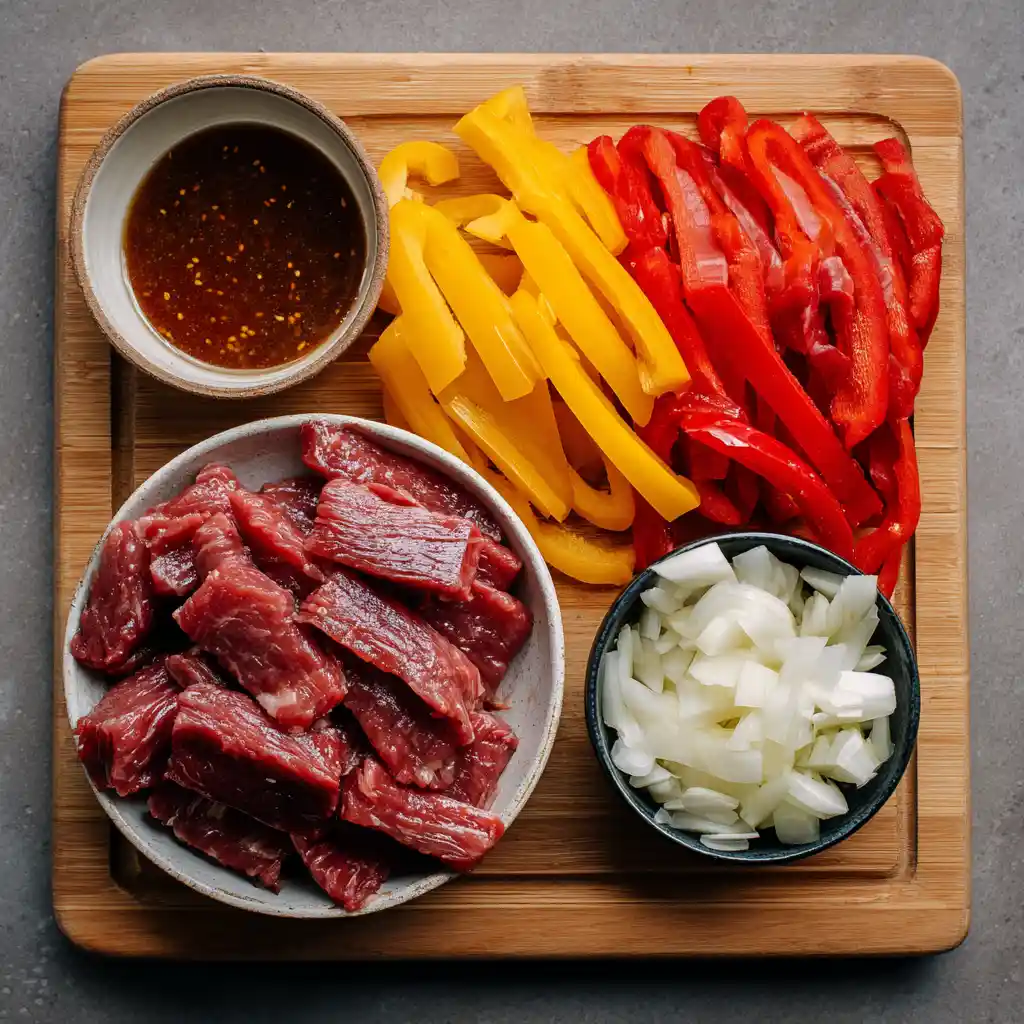
What Does Beijing Beef Taste Like? Is It Spicy?
Beijing Beef is all about bold contrast, sweet, tangy, savory, and just a touch spicy. The first bite hits you with a caramelized sweetness from sugar and hoisin sauce, followed by a gentle zing of tangy vinegar and a subtle warmth from sambal oelek or crushed chili paste. The crispy beef adds crunch and depth, while sautéed onions and bell peppers bring fresh, slightly charred undertones.
Is it spicy? Only mildly. The heat level is low and balanced, more warming than fiery. It’s approachable for most palates, but you can dial it up or down depending on how much chili you add to the sauce.
This sweet-heat harmony makes Beijing Beef stand out among other Panda Express favorites, it’s punchier than Broccoli Beef, and less sweet than Orange Chicken.
The real magic happens here, this bubbling sauce brings the sweet heat that defines Beijing Beef.
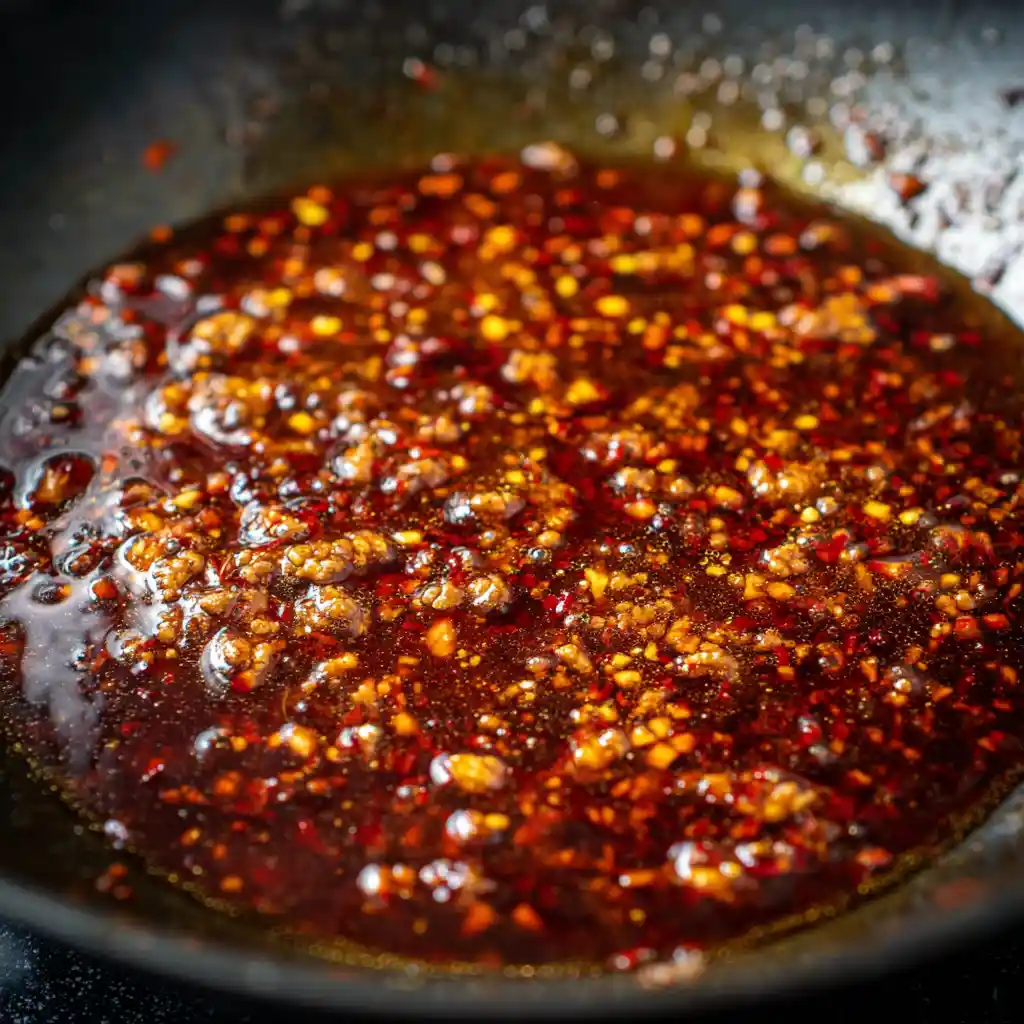
Ingredients for Authentic Beijing Beef
To get the signature taste and texture of Panda Express Beijing Beef, you’ll need a combination of pantry staples and a few key sauces. Here’s everything you need, broken down into components:
For the Crispy Beef
- 1 lb (450 g) flank steak, thinly sliced against the grain
- 2 tablespoons soy sauce
- 1 tablespoon Shaoxing wine (or dry sherry)
- 2 tablespoons cornstarch (for marinade)
- ½ cup (60 g) cornstarch (for coating)
- Neutral oil for frying (canola, peanut, or vegetable)
The Vegetables
- 1 red bell pepper, sliced into strips
- ½ medium onion, sliced
- 1 clove garlic, minced
- 1 teaspoon fresh ginger, grated (optional)
The Beijing Beef Sauce
- 3 tablespoons ketchup
- 2 tablespoons hoisin sauce
- 1½ tablespoons soy sauce
- 1½ tablespoons rice vinegar
- 1 tablespoon sugar
- 1 teaspoon sambal oelek or chili garlic sauce (adjust to taste)
- 1 teaspoon cornstarch (to thicken)
- ¼ cup (60 ml) water
Optional Garnish
- Sesame seeds
- Sliced green onions
Step-by-Step Instructions (Crispy Every Time)
Follow these precise steps to recreate the crispy texture and balanced flavor that makes Panda Express Beijing Beef a cult favorite, no sogginess, no shortcuts.
Step 1: Marinate the Beef
In a bowl, combine the thinly sliced flank steak with 2 tablespoons soy sauce, 1 tablespoon Shaoxing wine, and 2 tablespoons cornstarch. Toss well to coat every piece. Let marinate for at least 20 minutes (up to 1 hour) while you prep the other components.
Pro Tip: Thin slices are key, cut against the grain for tenderness.
Step 2: Make the Sauce
In a small bowl, whisk together ketchup, hoisin sauce, soy sauce, rice vinegar, sugar, sambal oelek, cornstarch, and water until smooth. Set aside.
Step 3: Fry the Beef
Heat about 1 inch of neutral oil in a heavy skillet or wok over medium-high heat (around 350°F / 175°C). Toss the marinated beef slices in the ½ cup of cornstarch for a final coating, then fry in batches until golden brown and crispy, about 2–3 minutes per batch. Drain on paper towels.
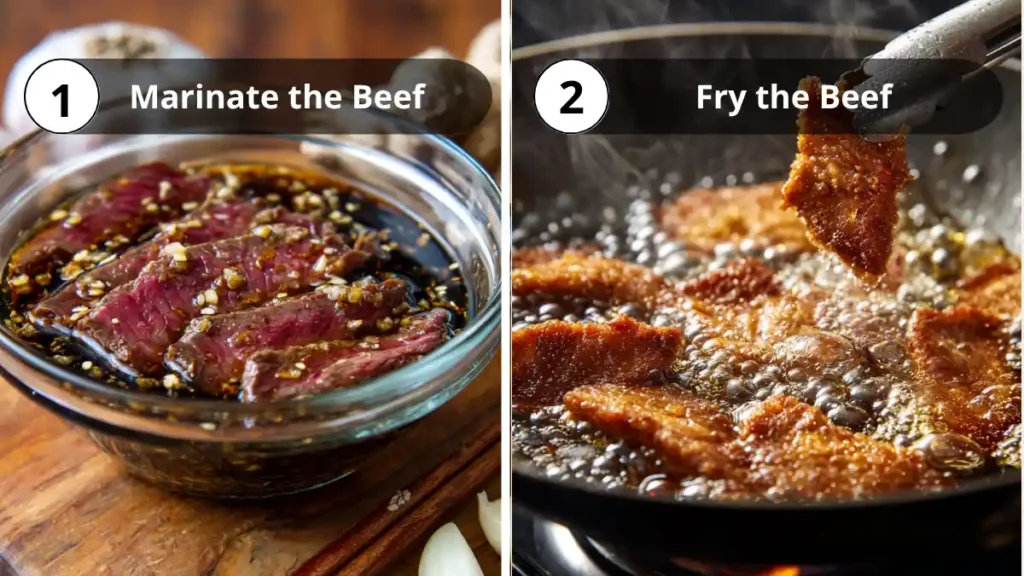
Pro Tip: Don’t overcrowd the pan, fry in small batches for even crisping.
Step 4: Sauté the Vegetables
In a clean wok or large skillet, add a small amount of oil. Stir-fry sliced onions and bell peppers for 2–3 minutes until slightly softened but still vibrant. Add garlic and ginger; sauté for another 30 seconds.
Step 5: Add the Sauce
Pour the prepared sauce into the wok and let it simmer for 1–2 minutes until it thickens and becomes glossy.
Visual cue: Look for bubbling edges and a syrupy texture.
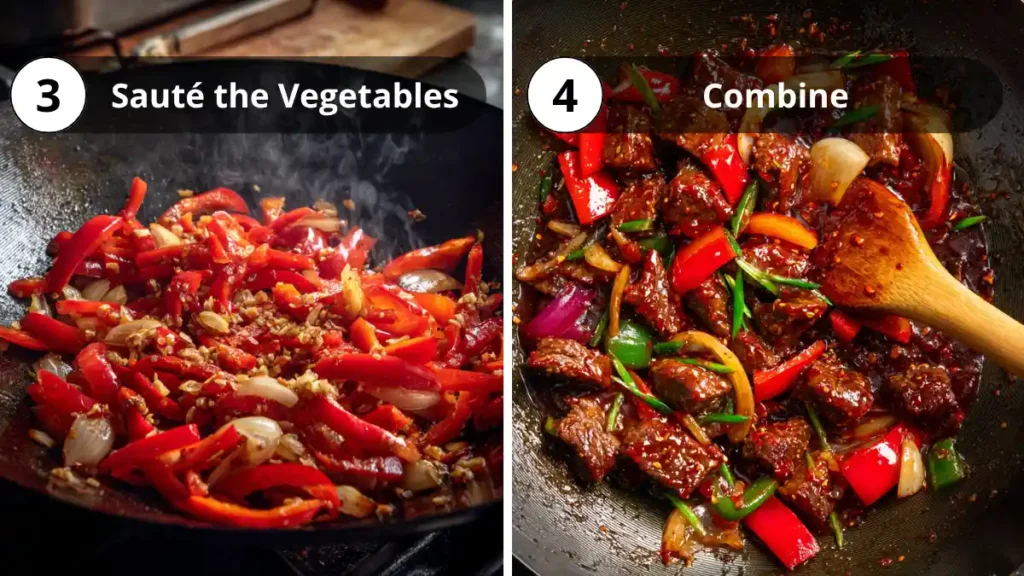
Step 6: Combine and Serve
Return the crispy beef to the pan and toss everything to coat thoroughly in the sauce. Serve hot, garnished with sesame seeds and green onions if desired.
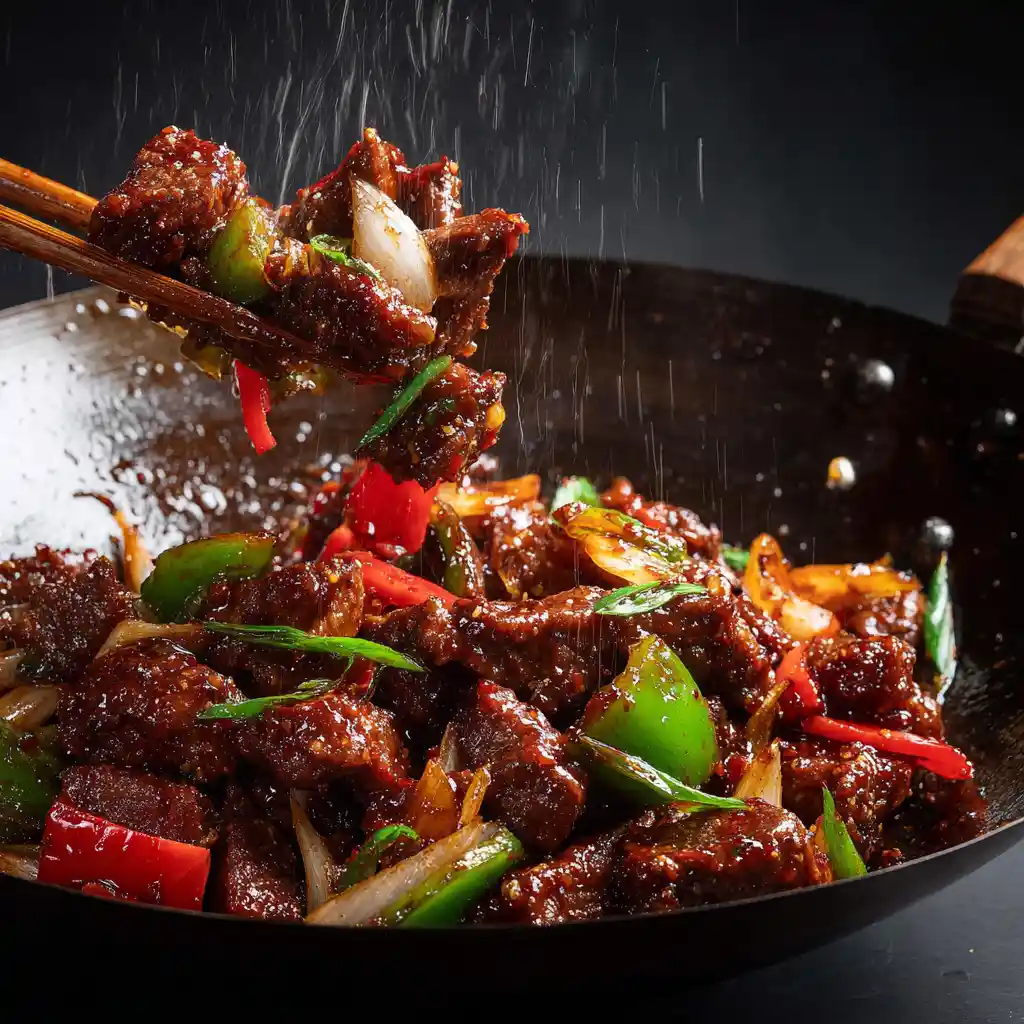
Pro-Level Tips, Tricks & Troubleshooting
Want ultra-crispy results and bold flavor every time? These tips will help you avoid the most common mistakes home cooks make when trying to recreate Beijing Beef.
1. Cut the Beef Thin and Against the Grain
This ensures tenderness and helps the marinade penetrate quickly. Freeze the beef for 15–20 minutes beforehand to make slicing easier.
2. Double-Coat for Maximum Crunch
Toss the marinated beef in cornstarch right before frying, this extra layer helps achieve that signature crispy exterior that holds up under sauce.
3. Get the Oil Hot Enough
Aim for 350°F (175°C). If the oil isn’t hot enough, the coating absorbs oil and turns soggy. Too hot, and it burns before cooking through.
Quick Test: Drop a small piece of coated beef into the oil, if it bubbles instantly and floats after a few seconds, it’s ready.
4. Sauce Last, and Only Briefly
Add the sauce to the wok after sautéing vegetables and simmer it for just a minute to thicken. Then toss the beef in quickly to prevent the coating from softening.
5. Don’t Skip the Sambal
Even a small amount of chili paste adds essential complexity. If you’re heat-sensitive, start with ½ teaspoon, but don’t omit it.
Substitutions & Dietary Tweaks (Gluten-Free, Keto, Nut-Safe)
Whether you’re managing food sensitivities or adjusting to fit your lifestyle, this dish can be easily adapted without losing its punchy flavor.
Gluten-Free Version
- Swap soy sauce for tamari or a certified gluten-free soy sauce alternative.
- Check hoisin and sambal labels, some brands contain wheat or gluten derivatives.
- Use cornstarch (naturally gluten-free) as your coating and thickener.
Low-Carb / Keto Modifications
- Replace sugar and ketchup in the sauce with low-carb alternatives like monk fruit sweetener and sugar-free ketchup.
- Skip the cornstarch coating and opt for a light egg white wash, then pan-fry or air-fry the beef instead.
- Serve with sautéed cabbage or cauliflower rice to keep carbs in check.
Nut-Free Assurance
- Beijing Beef is naturally nut-free, but always verify your hoisin and sambal oelek brands for cross-contamination or shared facilities if you have a severe allergy.
Pro Tip: This recipe can also be adapted for the air fryer, cook the coated beef at 400°F (200°C) for 10–12 minutes, flipping halfway through.
Nutrition, Macros & Allergen Table
Here’s a breakdown of the estimated nutritional values for one serving of homemade Beijing Beef (based on 4 servings total). These values can vary depending on the specific ingredients and cooking methods used.
| Nutrient | Per Serving (Approx.) |
|---|---|
| Calories | 520 |
| Protein | 27g |
| Total Fat | 28g |
| Saturated Fat | 4g |
| Carbohydrates | 41g |
| Sugars | 15g |
| Fiber | 2g |
| Net Carbs | 39g |
| Sodium | 980mg |
Allergen Information
| Allergen | Contains? | Notes |
|---|---|---|
| Gluten | Yes | From soy sauce, hoisin (use GF versions) |
| Soy | Yes | Soy sauce and hoisin |
| Nuts | No | Naturally nut-free, check sauce labels |
| Dairy | No | Completely dairy-free |
| Egg | No | Not used in standard recipe |
| Shellfish | No | Safe for shellfish allergies |
Note: Always read ingredient labels and verify with manufacturers if cooking for someone with severe allergies.
Beijing Beef: Origin Story & Cultural Footprint
Despite the name, Beijing Beef is not a traditional dish from China’s capital. It’s a creation of Panda Express, the largest Chinese-American fast-food chain in the United States, known for blending American tastes with Chinese-inspired flavors.
The Dish’s Debut
Beijing Beef was officially launched by Panda Express in 2008 as part of a campaign to introduce bold, new flavors beyond their classics like Orange Chicken. Developed by the company’s culinary innovation team, it was designed to deliver maximum flavor with crispy texture, sweet heat, and mass appeal.
Why “Beijing”?
The name is largely symbolic, it evokes an exotic, authentically “Chinese” impression for Western audiences. In reality, the dish is a modern, American invention with no known equivalent in traditional Beijing or regional Chinese cuisine.
Cultural Impact
Over time, Beijing Beef became one of Panda Express’s most popular offerings, sitting alongside Orange Chicken and Broccoli Beef. It’s now a go-to for fans of fusion takeout, and a favorite for home cooks seeking to replicate that nostalgic, mall-food-court flavor.
Flavor Profile Deep Dive: Why It Hits the Sweet-Heat Spot
Beijing Beef stands out because it strikes the perfect balance of contrast, each element in the dish plays a role in creating an addictive sweet-heat experience.
Sweet
The sweetness comes from a combination of ketchup, hoisin sauce, and sugar. Ketchup adds tang and umami, while hoisin brings a deeper, molasses-like sweetness with fermented undertones.
Tangy
Rice vinegar is the key to the dish’s brightness. It cuts through the richness of the fried beef and caramelized sugars, giving each bite a clean finish that keeps it from feeling heavy.
Savory
Soy sauce provides the salty, umami base, tying together the sugar, vinegar, and chili into a cohesive flavor.
Spicy (but mild)
The spice is subtle and approachable, thanks to sambal oelek or chili garlic paste. It adds warmth and depth, not burn. You feel the heat more as an accent than a dominant note.
Textural Contrast
Crispy beef meets tender vegetables and a glossy sauce, it’s this mix of crunch and silkiness that keeps you going back for another bite.
Summary: Sweet, tangy, savory, and just spicy enough, this is flavor engineering done right.
Beijing Beef vs Broccoli Beef vs Orange Chicken
If you’re trying to decide between Panda Express classics, here’s how Beijing Beef stacks up against Broccoli Beef and Orange Chicken, three dishes that showcase very different flavor profiles and textures.
Beijing Beef
- Flavor: Sweet, tangy, and mildly spicy.
- Texture: Crispy battered beef with sautéed bell peppers and onions.
- Sauce: Thick, glossy, with a chili-kissed vinegar backbone.
- Best for: Fans of bold contrast and crunchy texture.
Broccoli Beef
- Flavor: Lightly savory and garlicky.
- Texture: Stir-fried beef (not battered) and steamed broccoli—tender and fresh.
- Sauce: Soy-based, thin, and lightly seasoned.
- Best for: Those seeking a healthier, lighter option.
Orange Chicken
- Flavor: Sweet with citrus notes and a subtle tang.
- Texture: Crispy battered chicken, often stickier than Beijing Beef.
- Sauce: Orange-based glaze with sugar and vinegar.
- Best for: Anyone who loves sticky, sweet flavors without spice.
Verdict: Choose Beijing Beef for sweet-spicy crunch, Orange Chicken for sugary citrus, and Broccoli Beef for a mild, veggie-heavy meal.
Perfect Pairings & Serving Ideas
Beijing Beef is bold and flavorful, so the best pairings help balance its richness and heat while keeping things satisfying. Here’s how to round out your meal like a pro:
Classic Sides (Panda Express Style)
- Steamed White or Brown Rice: The most traditional pairing, mild and absorbent to let the sauce shine.
- Chow Mein Noodles: Adds extra texture and a savory punch; great for comfort-food cravings.
- Fried Rice: A more indulgent option that matches the flavor intensity of the beef.
Veggie Add-Ons
- Steamed Broccoli or Mixed Vegetables: Adds freshness and a healthy balance to the plate.
- Garlic Green Beans: A crisp, garlicky contrast that complements the sweet-sour sauce.
Fusion-Style Ideas
- Lettuce Wraps: Serve the beef in romaine or butter lettuce leaves for a lighter, low-carb twist.
- Stuffed Bao Buns or Sliders: Use leftovers as a filling for bao or sandwich rolls.
- Beijing Beef Bowls: Layer with rice, pickled veggies, and a drizzle of extra sauce.
Pro Tip: Make a large batch and portion it into lunch bowls, it reheats beautifully in a microwave or skillet.
FAQ – People Also Ask Answered
Beijing Beef includes crispy battered beef strips, red bell peppers, onions, and a signature sweet-tangy sauce made from ketchup, hoisin, soy sauce, vinegar, and chili paste.
It’s mildly spicy. The heat comes from sambal oelek or chili garlic sauce, but it’s balanced by sugar and vinegar, making it more flavorful than fiery.
The sauce combines ketchup, hoisin sauce, soy sauce, rice vinegar, sugar, water, cornstarch (for thickening), and sambal oelek for heat.
Mongolian Beef is typically sweeter and soy-based with no batter or frying—just stir-fried. Beijing Beef is battered, fried, and tossed in a sauce that’s tangier and spicier with a crispier texture.
It’s a signature Panda Express dish with crispy fried beef strips, bell peppers, and onions tossed in a bold, sweet-tangy sauce. It’s one of their most popular non-chicken entrees.
Yes, but more complex. While it shares the sweet and tangy profile of sweet and sour dishes, it adds mild heat and a deeper savory base with hoisin and chili sauce.
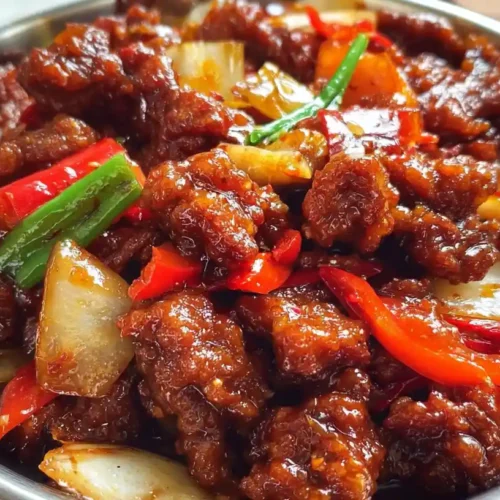
Better‑Than‑Takeout Beijing Beef Panda Express Recipe (Crispy Beef Strips)
Equipment
- Essential:
- Mixing bowls
- Heavy skillet or wok
- Tongs or slotted spoon
- Paper towels
- Optional:
- Deep-fry thermometer
- Small whisk for sauce
- Air-fryer (for low‑oil version)
Ingredients
For the Crispy Beef (Marinated + Coated):
- 1 lb 450 g flank steak, thinly sliced against the grain (sub: skirt or sirloin)
- 2 tbsp soy sauce substitution: tamari for gluten‑free
- 1 tbsp Shaoxing wine or dry sherry optional
- 2 tbsp cornstarch for marinade
- ½ cup 60 g cornstarch (for final coating)
- Neutral oil for frying canola, vegetable, or peanut*
Vegetables & Aromatics:
- 1 red bell pepper sliced into strips
- ½ medium onion sliced
- 1 clove garlic minced
- 1 tsp fresh ginger grated (optional)
Beijing Beef Sauce:
- 3 tbsp ketchup can use low‑sugar ketchup
- 2 tbsp hoisin sauce use gluten‑free brand if needed
- 1½ tbsp soy sauce or tamari
- 1½ tbsp rice vinegar
- 1 tbsp sugar or monk fruit sweetener
- 1 tsp sambal oelek or chili garlic sauce adjust heat to taste
- 1 tsp cornstarch for thickening
- ¼ cup 60 ml water
Optional Garnish:
- Sesame seeds
- Sliced green onions
Instructions
- Marinate the Beef: In a bowl, toss sliced flank steak with 2 tbsp soy sauce, Shaoxing wine, and 2 tbsp cornstarch. Let rest 20–60 minutes. Tip: Freeze beef for 15 min before slicing for easier, cleaner cuts.
- Prepare Sauce: Whisk together ketchup, hoisin, soy sauce, vinegar, sugar, sambal oelek, cornstarch, and water until smooth. Set aside.
- Coat & Heat Oil: Heat ~1 inch neutral oil in a skillet or wok to ~175 °C (350 °F). Toss marinated beef in ½ cup cornstarch just before frying.
- Fry the Beef: Fry in batches 2–3 minutes each until golden and crisp. Drain on paper towels. Don’t overcrowd the pan.
- Stir-Fry Vegetables: In the same pan, heat a little oil. Sauté onions and bell pepper ~2–3 minutes until tender-crisp, then stir in garlic and ginger for 30 sec.
- Add Sauce: Pour sauce in and simmer 1–2 minutes until glossy and thick.
- Combine & Serve: Add crispy beef back into the pan. Toss quickly to coat with sauce. Serve hot, garnished as desired.
- Pro Tip: Toss in reserved sauce and sauce just long enough to coat, this preserves crunch.
Notes
Nutrition Information (per serving, based on 4 servings)
SERVING: ~280 g | CALORIES: 520 kcal | CARBOHYDRATES: 41 g | PROTEIN: 27 g | FAT: 28 g | SATURATED FAT: 4 g | CHOLESTEROL: 75 mg | SODIUM: 980 mg | POTASSIUM: 600 mg | FIBER: 2 g | SUGAR: 15 g | VITAMIN A: 1200 iu | VITAMIN C: 60 mg | CALCIUM: 40 mg | IRON: 3 mgEstimated Cost
Total cost: Approximately $12 for 4 servings- Flank steak: $6
- Sauce & marinade ingredients (pantry staples): $3
- Vegetables: $2
- Oil, garnish, etc.: $1
Recipe Notes
- Ingredient Swaps: Use tamari for gluten‑free, egg white wash or air‑fryer for low‑carb version (skip cornstarch coating).
- Storage: Store leftovers in an airtight container in the fridge; reheats well in a skillet (using a splash of water) or microwave.
- Variations: Add honey or pineapple juice for extra sweetness; swap bell pepper with jalapeño for more heat; bulk up with broccoli or snap peas.
- Crunch Tip: Don’t toss beef into sauce too early, maintaining crisp texture is key.
Call-to-Action
Did this Beijing Beef Panda Express recipe give you that crisp, flavorful takeout fix? Share it with your friends, leave a star rating, and tell us how it turned out in the comments, including your own creative twists or seasoning hacks!Keyword Summary
beijing beef panda express recipe, crispy beef strips, hoisin sauce, sweet-tangy sauce, homemade Beijing beef, gluten‑free beijing beef, low‑carb panda beefConclusion & Call-to-Action
There you have it, an easy, step-by-step Beijing Beef Panda Express recipe that gives you all the bold flavor and crispy texture of the original, made right in your own kitchen. Whether you’re craving sweet heat, nostalgic takeout vibes, or just a new go-to stir-fry, this dish delivers.
Now it’s your turn:
- Tried it? Leave a comment and let us know how it turned out.
- Loved it? Rate the recipe with stars and share it with someone who needs a better-than-takeout fix.
- Made it your own? Upload a photo, we’d love to see your twist.
Bookmark this one, you’ll be making it again.




